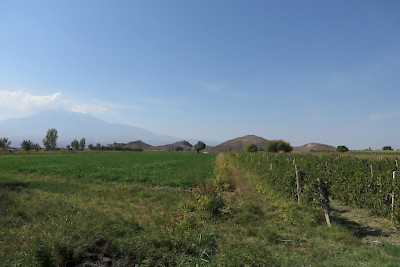Artaxias of Armenia

Artaxias was a son of a man named Zariadris and was a descendant of the Orontids who had been ruling in Armenia in the century after Alexander the Great. Of course this genealogy may have been a politically motivated fiction, because Artaxias was to found a new dynasty and may have seen benefits in a claim to belong to an earlier ruling family. That the relation between the last Orontid king, Orontes IV, and Artaxias was in fact not very friendly, may be deduced from the History of Armenia by Moses of Chorene, who - although writing centuries after the events - records a conflict.note
However this may be, Artaxias served the Seleucid ing Antiochus III the Great (r.222-187), who had put him in charge of northeastern Armenia (more or less the modern republic of that name). When Antiochus was defeated by the Romans in the Syrian War (192-188), Artaxias proclaimed his independence and was recognized as king by the Senate.
One of Rome’s demands to Antiochus was the extradition of one of his commanders, the Carthaginian general Hannibal Barca, the archenemy of Rome, who had fled to the Seleucid Empire. When he learned of this demand, Hannibal left the Seleucid court and traveled to Armenia, where Artaxias employed him as builder of a new capital, Artaxata, on the plain of the river Araxes.note
Artaxias waged several foreign wars and expanded his power. One of these conflicts was the "Pontic War", which broke out in 183 BCE. After king Pharnaces I of Pontus had seized the Greek city of Sinope, he was attacked from all sides: by Eumenes II Soter of Pergamon, by Prusias II the Hunter of Bithynia, by the Sarmatians (probably mercenaries), by Ariarathes IV Eusebes of Cappadocia, by a ruler named Acusilochus, by the Greek cities of Heracleia, Mesembria, Chersonese, and Cyzicus, and by Artaxias I of Armenia. The peace treaty is quoted by Polybius and although it is not clear whether Artaxias gained anything, it is certain that he was now recognized as a regional leader of some importance.note
Internally, Artaxias tried to consolidate his conquests as one state by promoting the Armenian language as lingua franca.
The Seleucids were unable to reconquer their lost northern territories, until Antiochus IV Epiphanes (r.175-164 BCE) became king. Having secured his rear with a war against Ptolemaic Egypt, he invaded Armenia in 165 and forced Artaxias into submission. However, Antiochus IV died in the next year and to retaliate, Artaxias supported a rebel within the Seleucid Empire, Timarchus of Miletus, who was in control of the eastern satrapies and was briefly recognized as king. The Seleucid king Demetrius I Soter (r.161-150) would eventually defeat the rebel in 161/160. The beginning of the revolt in c.162 BCE offers the terminus post quem of Artaxias' demise.note
Among Artaxias' last recorded deeds is an intervention in Sophene, a small state along the Euphrates in the west, which he wanted to divide with the Cappadocians. Their king Ariarathes V Eusebes Philopator was able to put a puppet king of his own, Mithrobuzanes, on the throne and the division never happened.
Artaxias must have died not much later and was the founder of the Artaxiad dynasty. The next known ruler of Armenia is Artavasdes I.